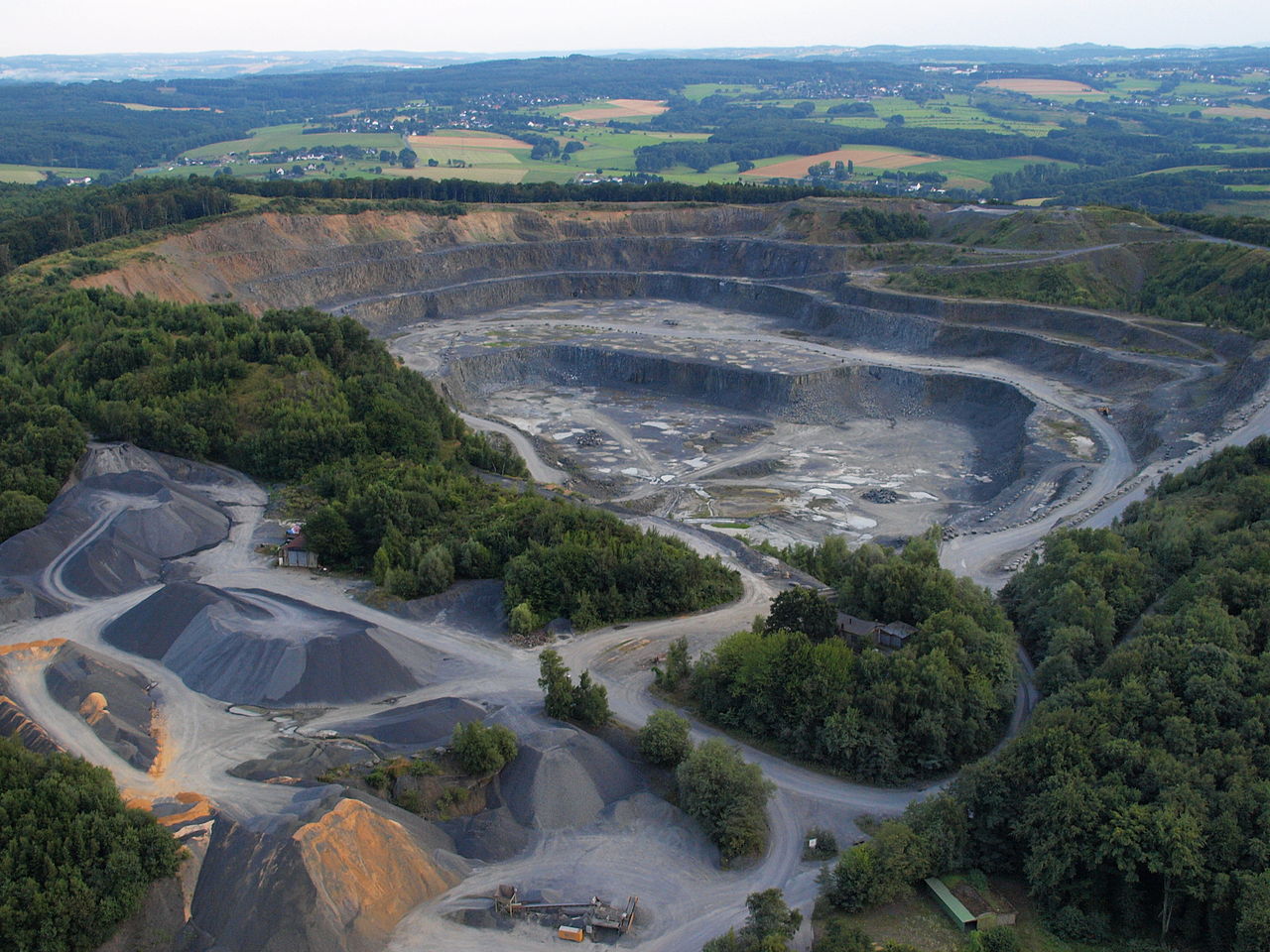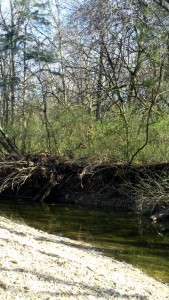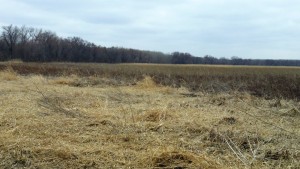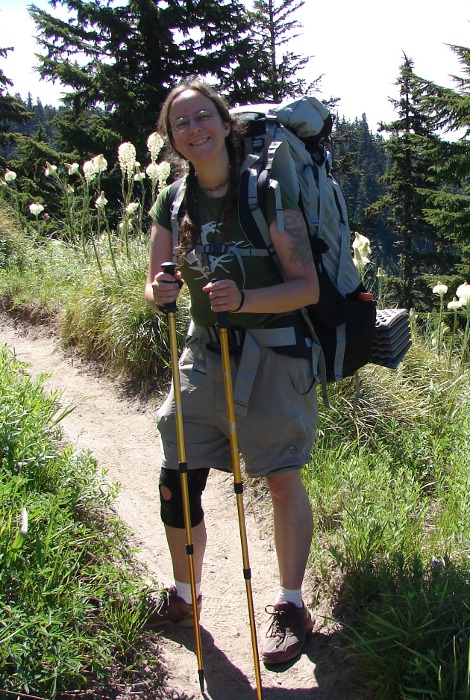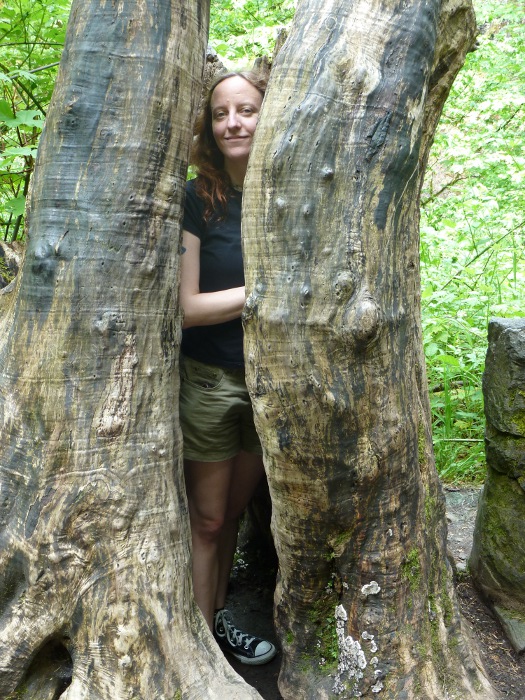Early June 2015, north side of Yocum Ridge, Mt. Hood Wilderness, Oregon
Don’t look down. Don’t look down. Don’t look–
I am bellied up against a massive pile of fine glacial till the size of an overturned cargo van, draped over it like laundry laid out in the sun. This late landslide has all but swallowed the narrow mountain trail my hiking buddy and I have been traveling, an alternate route of the Pacific Crest Trail that saved us a harrowing river crossing thousands of feet below. We’re three days into our backpacking trip, my first mini-through-hike, and his opportunity to add another section of the PCT to his already impressive record.
The surface of the till is gritty, all sand and no rocks–and no handholds. As my feet balance precariously on the six inches of trail width left uncovered, I lean hard into the mound, a task made more difficult by the forty pound pack on my back that raises my weight again by a third and lifts my center of gravity by several inches. I dare not straighten myself to rest my back or resettle the straps, because my toes and my balance are all that are keeping me from pitching backward down a hundred-foot drop at the edge of the half-foot trail. It makes no matter to me later that no one has actually died there in recent memory, only had to be pulled up from their long slide down by rescue teams. As far as I’m concerned the draw of till below me is gaping open to swallow me alive–and soon dead.
My friend calls to me encouragingly; I don’t register the words. He’s only a dozen feet away, safe on the other side of the washout, but he may as well be on the other side of the Muddy Fork valley. I’m halfway through: backward to known territory, or forward into the unknown. I hesitate, feeling the precious few inches of soil beneath my feet and the scrape of grit against my belly, shirt pulled up as I sag just a little.
If I panic, I’ll die.
I don’t even think to still my breathing or consciously calm myself. I’m terrified, but I know the cost of hasty actions. I look to my friend. “Stick your butt out more, and move your feet side to side. Keep your toes against the wall!” I do what he says, and I instantly feel my balance shift inward toward the side of the ridge. The pull of the pack back into empty air lessens, and I begin to move in a slow crab-crawl to my left.
It could have taken only seconds or days, I’m not sure. In those moments all that matters is the careful placing of feet and hands, the sensitive registration of my body’s weight and gravity as my balance shifted along the uneven surface of the till-hill. I become nothing more than a series of muscles, bones, tendons, lungs to breathe air and senses to choose the next action. There are no thoughts, no decisions, only the instinct to live. I am more aware than I have ever been in my entire life.
And then I am there, back on the undamaged trail, taking my hiking poles from my friend and moving away from the ordeal I just passed. A few feet pass and then we both stop to rest and breathe. He may have been through this sort of thing before, but he is shaken as well. We compose ourselves, have some water and rice crackers, and then continue our way along the trail toward the Muddy Fork of the Sandy River.
Before we arrive at the first crossing, we will have traversed two more of these landslides, with a third, lesser one on the far side of the valley.
November 2015, home, Portland, Oregon
I awaken in the dark of the morning; without my glasses I guess that the clock is beaming three-oh-something. Beside me my partner of several years is fast asleep; I’ve always envied his ability to spend the entire night in deep slumber while I wake and fret periodically.
Of course.
My bladder has decided to be unmerciful, and so I crawl out into the cool room to make the too-long journey down the hallway to the bathroom. I’ve done this so often I don’t even bother to turn on the light. It almost seems a waste of precious energy and heat to peel my arm away from where it’s wrapped around my ribs just to flick a single switch. I make it to my destination unscathed, and in mere moments I am ready to make the trek back.
Upon my arrival back at the bed, my lover has sprawled across my portion of mattress. Were I still in situ, his elbow would be laid across my head–not for the first time, either. I crawl back into the covers and attempt to salvage whatever heat I left. His ribs, on the other hand, get a bit of a nudge, and without breaking a snore he rolls back over onto his side.
…let the soft animal of your body/love what it loves
I curl up against his back, my feet tucked between his calves, one arm under his pillow and the other wrapped around his waist. Mary Oliver’s wild geese couldn’t get between us now. I take a few moments to settle, and then let my mind drift off into the daydream-land I’ve created for my very own bedtime stories, lulling myself back into safe slumber.
May 2010, Providence Portland Medical Center, Portland, Oregon
The pain is bad enough that I am openly crying, something that hasn’t happened since I was a child. This is no ear infection, or the bone in my hand I fractured when I tripped and fell in a spontaneous race with a friend. No, this has potentially worse consequences. Over the past couple of days I’ve had a growing sharp pain in my abdomen, first a general discomfort all over (indigestion, perhaps) but then worsening, and localizing in the lower right quadrant. I don’t think I’ve misplaced my appendix; all my other organs are as they should be. But the doctor has decided to send me to stay overnight for IV antibiotics, close monitoring, and possibly surgery.
I call my recently ex-husband, with whom I will only live a few more weeks until my new apartment is ready, to come pick up our car, and would he please bring me my laptop? Even on the phone he sounds more resentful than concerned, an increasing trend in our strained–but thankfully temporary–living situation. I am settled into a wheelchair and taken over to the care unit; although I could have walked, the nurse insists. This simple action of denying me my own mobility suddenly makes me feel weak and vulnerable in a way I have never been before, not even as a seemingly invincible child. The surgeon on duty terrifies me with threats of removing a section of intestine if I don’t get better; one of the diverticuli has burst open and I have a raging infection that could kill me. He has the bedside manner of a vulture.
I’m so scared.
I keep my sanity through my connections online, keeping in touch with people who are unable to visit but who care nonetheless. My closest friend visits as often as he is able, but obligations pull him away the next day. My tiny veins reject first one IV needle, then a second, then a third, then a fourth, until all the veins on the tender undersides of my elbows are blown and the nurses must resort to my more sensitive hands. I barely sleep; someone is in every hour to take my vitals, though my heart still beats and my temperature fluctuates less and less.
I rage at my body, as the restlessness eats at my mind. How could it betray me? I was only thirty-one; I’d been running three times a week for a few months now, a way to cope with the disruption of my life story that was divorce. I should be out there in the warm spring sunshine, my feet slapping against sidewalks in the wetland park, shaking off the trauma of the previous few years’ travails. Instead, I had doctors telling me I was closer to death than at any point in my existence; only the needle in my hand would know for sure whether more drastic measures should be taken.
Of course, it was another doctor who told me that my running routine was part of how I managed to rebound so quickly from the threat in my belly. My immune system, depressed for so long from too many hours in closed office buildings, and an increasingly stressful living situation, began to recuperate as my muscles firmed and the blood flowed more quickly through my veins. So now that effort pays off, as a mere twelve hours into the IV antibiotics the pain lessens enough that I am able to bend at the waist again without screaming. I even wheel the IV cart into the hallway and show the nurse on duty how, standing on one leg, I can pull my other knee up to my chest and it only hurts a bit, really!
It will be another day and a half before I am released, allowed to run–or at least limp–free, back to the new life I am creating. It is a life more aware of mortality; though the asthma I’ve had since I was young has limited my activities in cold weather and sometimes even curtailed my warm-weather running, it’s never tried to kill me. My gut, on the other hand, quickly flooded me with deadly bacteria with just the tiniest pinprick of a hole.
I listened to that breach, and I attended to it–thankfully I still had insurance at the time, or I might have become one of the thousands of uninsured who die from curable diseases each year for fear of crippling debt. But it left me scarred, in mind if not body. Now, even six years later, any tiny twinge in my midsection makes the hairs stand up on the back of my neck. I go back to that helpless feeling, tethered to a sterile hospital bed by tubes of medicines, made impersonal with the thin drape of fabric they call a “gown”. And so I keep running, hoping to outrun that experience again, and I lift weights, ready to fight should it lurch across my path once more.
January 2016, Planet Fitness, Portland, Oregon
I just turned thirty-seven a couple of months ago. I went back to the gym for the first time in years just a few days before my birthday, though I paid for the membership weeks before then. I’m a bit of a procrastinator.
I hate the treadmill. Running in place never has the same appeal as wandering city streets and traversing parks, and it’s tougher to keep myself focused. The bounce of the belt below my feet never felt natural, and I long for grass and a bit of uneven terrain to challenge me. No hope there, though. So I make myself run a mile and a half–that’s it. I’ll just try to run that 1.5 faster each time.
Finally.
I step off the treadmill and, with a stop by the drinking fountain, I pop open my locker for my weight gloves. A long walk around the herd of ellipticals brings me to the rack of barbells, my first stop. I’ve left behind the twenty-pound weight, and pick up the thirty for a round of arm curls to get me started.
This is not the fast-paced churn of running, legs tangling and untangling with greater speed. No, here I get to watch the muscles work in slower motion as I face the mirrored south wall. I’ve never been especially strong in my upper body, but over the past two months I’ve already put on a respectable bit of muscle. My ritual includes closing out my night with a protein bar and some jerky, easily thirty-five grams for my body to grow on.
But not just yet. Now I am moving the metal bar up toward my chest and back down; I can feel where the muscles in my back and shoulders and arms and chest have all responded to this old-new stimulus. Seventeen-year-old track runner me would have been jealous; I’m already planning for when I move up to the forty pound weight. I’m squatting forty later tonight, and my quads tense in preparation.
I ran faster when I was younger; I don’t know that I could do an eight minute mile now. But what I lose in speed, I make up for in strength and stamina. There is no peak to my body; there is only change, and evolution. And, yes, eventually there will be decline in more respects than speed–but that’s an opportunity to become more proficient in other body-ways.
Perhaps in my golden years I shall explore the fine art of being slow.
Like this:
Like Loading...


